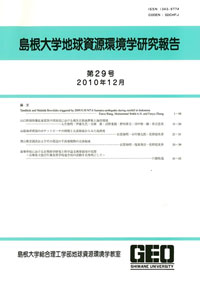島根大学総合理工学部地球資源環境学教室
ISSN:1343-9774

ダウンロード数 : ? 件
この文献の参照には次のURLをご利用ください : https://ir.lib.shimane-u.ac.jp/6128
島根大学地球資源環境学研究報告 22
2003-12-27 発行
Whole-rock analyses of sandstones and mudrocks from the Oshima Belt, Oshima Peninsula, SW Hokkaido
Roser BarryPaul
植田 勇人
川村 信人
ファイル
内容記述(抄録等)
The Carboniferous-Jurassic Oshima Belt is a Jurassic accretionary complex exposed in the Oshima Peninsula of SW Hokkaido.This report contains whole-rock X-ray fluorescence analyses of 82 turbidite sandstones and mudrocks collected from terrigenous units in the Ohkamotsugawa,Esashi,Kamiiso,and Toi Complexes,which crop out from west to east.
The results show the Oshima sandstones are comparatively silica-rich(generally 73-85 wt% SiO_2),and are depleted in CaO,Na_2O,Sr,and ferromagnesian elements(MgO,Fe_2O_3T,Sc,Ni,Cr and V)relative to average upper continental crust.Sandstones and mudrocks form linear trends on oxide/element-Al_2O_3 variation diagrams,typical of sorting fractionation.SiO_2,Na_2O,and to a lesser extent CaO and Sr decrease in abundance as Al_2O_3 increases from sandstone to mudstone,whereas all other elements analyzed except MnO,Sr,and Zr increase in abundance.Elemental abundances in Ohkamotsugawa,Esashi,and Kamiiso sandstones are broadly compatible with derivation from a felsic source.Enrichment of ferromagnesian elements(Fe,Mg,Sc,Ni,Cr,V)in some Toi Complex sandstones are suggestive of a minor mafic to intermediate volcaniclastic component,lending support to the proposed bidirectional source for that unit.
The results show the Oshima sandstones are comparatively silica-rich(generally 73-85 wt% SiO_2),and are depleted in CaO,Na_2O,Sr,and ferromagnesian elements(MgO,Fe_2O_3T,Sc,Ni,Cr and V)relative to average upper continental crust.Sandstones and mudrocks form linear trends on oxide/element-Al_2O_3 variation diagrams,typical of sorting fractionation.SiO_2,Na_2O,and to a lesser extent CaO and Sr decrease in abundance as Al_2O_3 increases from sandstone to mudstone,whereas all other elements analyzed except MnO,Sr,and Zr increase in abundance.Elemental abundances in Ohkamotsugawa,Esashi,and Kamiiso sandstones are broadly compatible with derivation from a felsic source.Enrichment of ferromagnesian elements(Fe,Mg,Sc,Ni,Cr,V)in some Toi Complex sandstones are suggestive of a minor mafic to intermediate volcaniclastic component,lending support to the proposed bidirectional source for that unit.
Other Article
PP. 93 - 105
PP. 107 - 110
PP. 111 - 120
PP. 121 - 133
PP. 161 - 166
PP. 167 - 172
